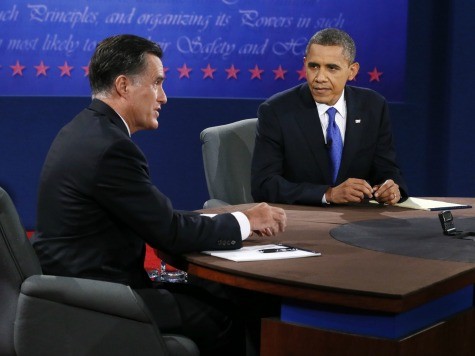
With his smart-ass “horses and bayonets” remark in Monday night’s debate, in response to Mitt Romney’s concern about a shrinking Navy, the President again showed his ignorance about military readiness and how to keep the world safe.
Obama explained, in condescending jibes, that the nature of our military has changed and Romney’s thinking was antiquated. “We have,” said the President, “these things called aircraft carriers where planes land on them… so the question is not a game of Battleship, where we’re counting the ships. It’s, what are our capabilities?”
The size of the world hasn’t changed, and despite Obama’s inflated ideas of his own capabilities, is unlikely to in the foreseeable future. Ships can only be in one place at a time, and although they may travel faster than they did in 1917 (the last time the Navy had as few ships as today, according to Romney), they still don’t sail as fast as airplanes fly.
Obama has advocated for a pivot of US forces to Asia which would require deploying 60% of naval resources to the Pacific and 40% to the Atlantic. Romney does not disagree with that shift (the split is now roughly 50-50), but according to former Reagan-era Navy Secretary and Romney advisor John Lehman, Romney would not do so at the expense of maintaining a strong presence in the rest of the world. Obama’s less-than-300-ship Navy, however, would require it. Just to cite one example, as long as tensions remain high in the Middle East – which could be for a very long time — a considerable naval presence will be required there.
If we are going to “pivot” to Asia, eyes will, by necessity, be on China. As I pointed out in a column here last week, China is determined to force the US out of the Western Pacific and force us to sever our alliances with Japan, Philippines, Singapore, and countries in Southeast Asia. In addition, China, which launched its own carrier last year, wants to close sea lanes and to override the rule of law by claiming that 90% of the South China Sea, or 2.5 million square miles of water and the fish, oil and other minerals beneath the surface belonging to it – something that flies in the face of everything the United States stands for. China’s ongoing development of ballistic missiles and cyber warfare capabilities could further hamper the US Navy’s ability to operate in that region without a robust fleet.
How would we protect our interests in this vital part of the world without an adequate navy? The Navy now operates in the Pacific out of Pearl Harbor and Navy Commanders there are on record as needing more ships – not necessarily aircraft carriers, but frigates and other modern and sophisticated ships capable of moving quickly and capable of white-water operations. These ships are not going to take on the Chinese single-handedly – not by a long shot – but must just show the flag. If fired upon, the Chinese know there is plenty of back-up in the US arsenal. But if we are not a visible presence there is no “red line.” Just this past week, the USS George Washington, one of our largest and most modern aircraft carriers, patrolled off the coast of Vietnam to show our flag to the Chinese and to remind them that we still have a vital interest in the area.
“China will take this (cruise) as another expression by the United States of its desire to maintain regional domination,” Denny Roy, a senior fellow at the East-West Center in Hawaii, told the Northwest Asian Weekly. “The U.S also wants to send a message to the region that it is here for the long haul… and that it wants to back up international law.”
To send such a message takes more than a few ships. According to the International Institute for Strategic Studies’ Military Balance 2012, the U.S. has 114 principal surface ships (aircraft carriers, cruisers, destroyers, and frigates) and 57 tactical submarines. Unfortunately, fewer than half will be deployed at the same time: some will be preparing to deploy, others recently returned and still others in maintenance. And of course few of these ships operate independently — a Carrier Strike Group, for example, operates with a minimum of six ships — a carrier, a cruiser, two destroyers, an attack submarine, and a supply ship. So deployment of three carrier strike groups to any one part of the world will substantially deplete availability anywhere else.
Another reason for a strong navy is trade – the foundation of the world economy. Maritime transport makes up about 80% of global trade, and it is estimated its use will double over the next twenty years. Without the peace-keeping capacity of a global naval presence – a US naval presence – any disruption of free trade routes would cause devastation to parts of the world economy.
But a larger Navy – even the 350 ship Navy which Mitt Romney wants – costs vast sums of money. The new Gerald Ford-class aircraft carriers, for example, will each cost $14 billion, and Arleigh Burke class destroyers $3-4 billion a piece.
In any case, the issue begs for a more serious discussion than a glib remark about horses and bayonets. But that might just be too much to expect, given the source.

COMMENTS
Please let us know if you're having issues with commenting.